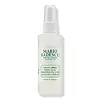What's inside
What's inside
 Key Ingredients
Key Ingredients

 Benefits
Benefits

 Concerns
Concerns

No concerns
 Ingredients Side-by-side
Ingredients Side-by-side

Water
Skin ConditioningLavandula Angustifolia Flower Water
Skin ConditioningPropylene Glycol
HumectantPolysorbate 20
EmulsifyingAloe Barbadensis Leaf Juice
Skin ConditioningLavandula Angustifolia Oil
MaskingChamomilla Recutita Flower Extract
MaskingFucus Vesiculosus Extract
Emollient3-O-Ethyl Ascorbic Acid
Skin ConditioningThymus Vulgaris Leaf Extract
Skin ProtectingSilver Citrate
AntimicrobialPotassium Sorbate
PreservativeSodium Benzoate
MaskingBenzophenone-4
UV AbsorberTriethanolamine
BufferingZeolite
AbsorbentSodium Sulfate
Citric Acid
BufferingSodium Chloride
MaskingCI 60730
Cosmetic ColorantWater, Lavandula Angustifolia Flower Water, Propylene Glycol, Polysorbate 20, Aloe Barbadensis Leaf Juice, Lavandula Angustifolia Oil, Chamomilla Recutita Flower Extract, Fucus Vesiculosus Extract, 3-O-Ethyl Ascorbic Acid, Thymus Vulgaris Leaf Extract, Silver Citrate, Potassium Sorbate, Sodium Benzoate, Benzophenone-4, Triethanolamine, Zeolite, Sodium Sulfate, Citric Acid, Sodium Chloride, CI 60730
Water
Skin ConditioningAloe Barbadensis Leaf Juice
Skin ConditioningNiacinamide
SmoothingSodium Hyaluronate
HumectantCocos Nucifera Water
MaskingAcanthopanax Senticosus Root Extract
Skin ConditioningInonotus Obliquus Extract
Skin ConditioningRhaponticum Carthamoides Root Extract
Skin ConditioningRhodiola Rosea Extract
EmollientSelaginella Lepidophylla Extract
EmollientSodium Benzoate
MaskingSodium Sulfite
PreservativeTrehalose
HumectantPotassium Sorbate
PreservativePPG-5-Ceteth-20
EmulsifyingCeramide AP
Skin Conditioning1,2-Hexanediol
Skin ConditioningMaltodextrin
AbsorbentCaprylyl Glycol
EmollientPhenoxyethanol
PreservativeCitric Acid
BufferingWater, Aloe Barbadensis Leaf Juice, Niacinamide, Sodium Hyaluronate, Cocos Nucifera Water, Acanthopanax Senticosus Root Extract, Inonotus Obliquus Extract, Rhaponticum Carthamoides Root Extract, Rhodiola Rosea Extract, Selaginella Lepidophylla Extract, Sodium Benzoate, Sodium Sulfite, Trehalose, Potassium Sorbate, PPG-5-Ceteth-20, Ceramide AP, 1,2-Hexanediol, Maltodextrin, Caprylyl Glycol, Phenoxyethanol, Citric Acid
 Reviews
Reviews

Ingredients Explained
These ingredients are found in both products.
Ingredients higher up in an ingredient list are typically present in a larger amount.
Aloe Barbadensis Leaf Juice comes from leaves of the aloe plant. Aloe Barbadensis Leaf Juice is best known for helping to soothe sunburns. It is also anti-inflammatory, moisturizing, antiseptic, and can help heal wounds.
Aloe is packed with good stuff including Vitamins A, C, and E. These vitamins are antioxidants, which help fight free-radicals and the damage they may cause. Free-radicals are molecules that may damage your skin cells, such as pollution.
Aloe Barbadensis Leaf Juice also contains sugars. These sugars come in the form of monosaccharides and polysaccharides, folic acid, and choline. These sugars are able to help bind moisture to skin.
It also contains minerals such as calcium, 12 anthraquinones, fatty acids, amino acids, and Vitamin B12.
Learn more about Aloe Barbadensis Leaf JuiceCitric Acid is an alpha hydroxy acid (AHA) naturally found in citrus fruits like oranges, lemons, and limes.
Like other AHAs, citric acid can exfoliate skin by breaking down the bonds that hold dead skin cells together. This helps reveal smoother and brighter skin underneath.
However, this exfoliating effect only happens at high concentrations (20%) which can be hard to find in cosmetic products.
Due to this, citric acid is usually included in small amounts as a pH adjuster. This helps keep products slightly more acidic and compatible with skin's natural pH.
In skincare formulas, citric acid can:
While it can provide some skin benefits, research shows lactic acid and glycolic acid are generally more effective and less irritating exfoliants.
Most citric acid used in skincare today is made by fermenting sugars (usually from molasses). This synthetic version is identical to the natural citrus form but easier to stabilize and use in formulations.
Read more about some other popular AHA's here:
Learn more about Citric AcidPotassium Sorbate is a preservative used to prevent yeast and mold in products. It is commonly found in both cosmetic and food products.
This ingredient comes from potassium salt derived from sorbic acid. Sorbic acid is a natural antibiotic and effective against fungus.
Both potassium sorbate and sorbic acid can be found in baked goods, cheeses, dried meats, dried fruit, ice cream, pickles, wine, yogurt, and more.
You'll often find this ingredient used with other preservatives.
Learn more about Potassium SorbateSodium Benzoate is a preservative. It's used in both cosmetic and food products to inhibit the growth of mold and bacteria. It is typically produced synthetically.
Both the US FDA and EU Health Committee have approved the use of sodium benzoate. In the US, levels of 0.1% (of the total product) are allowed.
Sodium benzoate works as a preservative by inhibiting the growth of bacteria inside of cells. It prevents the cell from fermenting a type of sugar using an enzyme called phosphofructokinase.
It is the salt of benzoic acid. Foods containing sodium benzoate include soda, salad dressings, condiments, fruit juices, wines, and snack foods.
Studies for using ascorbic acid and sodium benzoate in cosmetics are lacking, especially in skincare routines with multiple steps.
We always recommend speaking with a professional, such as a dermatologist, if you have any concerns.
Learn more about Sodium BenzoateWater. It's the most common cosmetic ingredient of all. You'll usually see it at the top of ingredient lists, meaning that it makes up the largest part of the product.
So why is it so popular? Water most often acts as a solvent - this means that it helps dissolve other ingredients into the formulation.
You'll also recognize water as that liquid we all need to stay alive. If you see this, drink a glass of water. Stay hydrated!
Learn more about Water